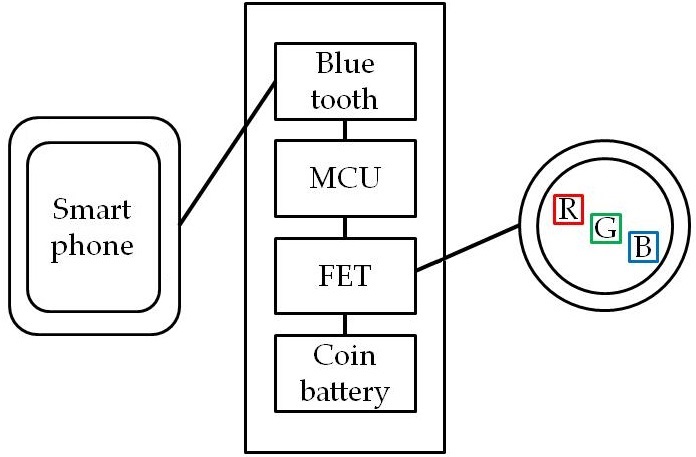Wireless Low Power Light Emitting Device with RGB LED
Keywords:
Color therapy, RGB LED, Color combination, Light emitting deviceAbstract
Color therapy is a type of alternative medicine. It utilizes the emission of a specific wavelength of light to treat diseased areas. This study presents a wireless, low-power light-emitting device with RGB LED to conduct color therapy. The device is small-sized, adhesive to the skin, and without a tether line for power or communication. Aided by the property of skin adhesiveness, the device provides a therapeutic effect comparable to that of available devices, over a short radiation distance and consumes low power. The therapeutic dosage parameters including color wavelength combination, LED brightness, and illumination time can be regulated through the smartphone application. The wavelength consistency over intensities and the intensity accuracy were validated. With effective calibration, the emission of light by the LED can be effectively regulated to ensure therapeutic effects.
References
Y. Y. Huang, A. C. Chen, J. D. Carroll, and M. R. Hamblin, “Biphasic dose response in low level light therapy,” Dose-Response, vol. 7, no. 4, pp. 358-383, October 2009.
C. C. Hung, “Development of the RGB LEDs color mixing mechanism for stability the color temperature at different projection distances,” Technology and Health Care, vol. 24, pp. S271-S280, December 2015.
N. Adamskaya, N. P. Dungel, R. Mittermayr, J. Hartinger, G. Feichtinger, K. Wassermann, H. Redl, and M. van Griensven, “Light therapy by blue LED improves wound healing in an excision model in rats,” Injury, vol. 42, no. 9, pp. 917-921, September 2011.
H. Chung, T. Dai, S. K. Sharma, Y. Y. Huang, J. D. Carroll, and M. R. Hamblin, “The nuts and bolts of low-level laser (light) therapy,” Annals of Biomedical Engineering. vol. 40, no. 2, pp. 516-533, February 2012.
M. H. Keuper, G. Harbers, and S. Paolini, “RGB LED illuminator for pocket‐sized projectors,” SID Symposium Digest of Technical Papers, vol. 35, no. 1, pp. 943-945, May 2004.
D. A. Steigerwald, J. C. Bhat, D. Collins, R. M. Fletcher, M. O. Holcomb, M. J. Ludowise, P. S. Martin, and S. L. Rudaz, “Illumination with solid state lighting technology,” IEEE journal of selected topics in quantum electronics, vol. 8, no. 2, pp. 310-320, March 2002.
D. Jakovels, I. Kuzmina, A. Berzina, and J. Spigulis, “RGB imaging system for monitoring of skin vascular malformation's laser therapy,” Proc. SPIE Photonics Europe, vol. 8427, pp. 842737-842737-6, June 2012.
Y. I. Shin, N. G. Kim, K. J. Park, D. W. Kim, G.Y. Hong, and B.C. Shin, “Skin adhesive low-level light therapy for dysmenorrhoea: a randomized, double-blind, placebo-controlled, pilot trial,” Archives of Gynecology and Obstetrics, vol. 286, no. 4, pp. 947-952, October 2012.
G. Y. Hong, B. C. Shin, S. N. Park, Y. H. Gu, N. G. Kim, K. J. Park, S. Y. Kim, and Y. I. Shin, “Randomized controlled trial of the efficacy and safety of self-adhesive low-level light therapy in women with primary dysmenorrhea,” International Journal of Gynecology & Obstetrics, vol. 133, no. 1, pp. 37-42, April 2016.
L. B. Hooi, “Understand RGB LED mixing ratios to realize optimal color in signs and displays,” LEDs magazine, pp. 67-72, May 2013.
A. Perduijn, S. Krijger, J. Claessens, N. Kaito, T. Yagi, S. Hsu, M. Sakakibara, T. Ito, and S. Okada, “Light output feedback solution for RGB LED backlight applications,” SID Symposium Digest of Technical Papers, vol. 34, no. 1, pp. 1254-1257, May 2003.
R. B. Johnson, D. Esparza, V. N. Mahajan, I. Moreno, and S. Thibault, “Color patterns in a tapered light pipe with RGB LEDs,” Proc. SPIE 2010, SPIE Digital Library Press, vol. 7786, August 2010, pp. 77860I-1-77860I-7.

Published
How to Cite
Issue
Section
License
Copyright (c) 2017 International Journal of Engineering and Technology Innovation

This work is licensed under a Creative Commons Attribution-NonCommercial 4.0 International License.
Copyright Notice
Submission of a manuscript implies: that the work described has not been published before that it is not under consideration for publication elsewhere; that if and when the manuscript is accepted for publication. Authors can retain copyright in their articles with no restrictions. Also, author can post the final, peer-reviewed manuscript version (postprint) to any repository or website.

Since Jan. 01, 2019, IJETI will publish new articles with Creative Commons Attribution Non-Commercial License, under Creative Commons Attribution Non-Commercial 4.0 International (CC BY-NC 4.0) License.
The Creative Commons Attribution Non-Commercial (CC-BY-NC) License permits use, distribution and reproduction in any medium, provided the original work is properly cited and is not used for commercial purposes.



.jpg)


